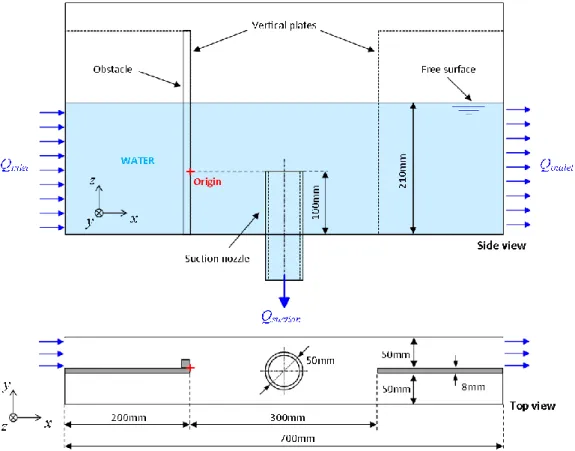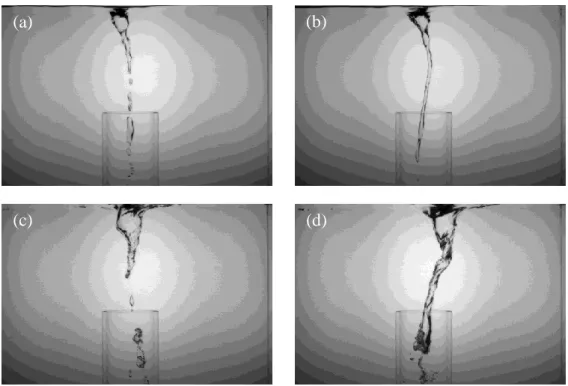HAL Id: cea-02492547
https://hal-cea.archives-ouvertes.fr/cea-02492547
Submitted on 27 Feb 2020HAL is a multi-disciplinary open access archive for the deposit and dissemination of sci-entific research documents, whether they are pub-lished or not. The documents may come from teaching and research institutions in France or abroad, or from public or private research centers.
L’archive ouverte pluridisciplinaire HAL, est destinée au dépôt et à la diffusion de documents scientifiques de niveau recherche, publiés ou non, émanant des établissements d’enseignement et de recherche français ou étrangers, des laboratoires publics ou privés.
Experimental study of gas entrainment from surface
swirl
B. Moudjed, J. Excoffon, R. Riva, L. Rossi
To cite this version:
B. Moudjed, J. Excoffon, R. Riva, L. Rossi. Experimental study of gas entrainment from surface swirl. 22ème Congrès Français de Mécanique, Aug 2015, Lyon, France. �cea-02492547�
22
èmeCongrès Français de Mécanique Lyon, 24 au 28 Août 2015
Experimental study of gas entrainment
from surface swirl
B. MOUDJED
a, J. EXCOFFON
a, R. RIVA
aand L. ROSSI
aa. CEA, DEN/DANS/DM2S/STMF/LIEFT, CEA Saclay, F-91191 Gif-sur-Yvette Cedex,
France
brahim.moudjed@cea.fr
(
brahim.moudjed@yahoo.fr
),
jacques.excoffon@cea.fr
,
roland.riva@cea.fr
,
lionel.rossi@cea.fr
.
Key words: Sodium cooled fast reactor nuclear, Gas entrainment, Surface
swirl, Flow visualization
In Sodium cooled fast reactors (NaSFR), the presence of eddies at the free surface and the downward flow created by the suction of hot liquid sodium by the intermediate heat exchanger can provoke the entrainment of gas (argon). Readers can refer to [1] for more information about sodium nuclear reactors. Such entrainment could induce the transport of a large quantity of gas through the core and could lead to the accumulation of gas pockets close to the core of the reactor [2, 3]. In consequence, the absence and quantification of gas entrainment is a relevant issue for safety studies.
The present study focuses on gas entrainment from surface swirls trough an experimental apparatus in water. The objectives are firstly to identify the experimental condition of gas entrainment occurrence, secondly, to define gas entrainment occurrence frequencies and thirdly, to characterize the physical mechanisms involved.
Several experimental studies addressing the topic of gas entrainment in different geometries and with different liquid medium can be found in the literature. Baum et al. [4], Takashi et al. [5] or Egushi et al. [6] used cylindrical cavity to investigate surface tension and scale effect. However, the gas entrainment is sustained in these studies whereas it is intermittent in NaSFR. Then, Ezure et al. [7] and Kimura et al. [8], used an open channel flow where gas entrainment appears intermittently by the combination of a shear flow (produced between a horizontal flow and a stagnant flow) and a vertical pumping below the free surface. They obtain a gas entrainment mapping according to the inlet and suction flow rates.
Experimental set up of the present study is close to that of Ezure et al. and Kimura et al. It is designed with a rectangular cavity opened at the top, two vertical plates (separating the inlet and the outlet flow from a stagnant region) and a 50mm diameter suction nozzle (with a height of 100mm) placed at the bottom of the cavity. The figure 1 illustrates the rig filled of water leading to the flow dimensions, with a free surface, 700 mm x 108 mm x 210 mm.
The shear flow is created in the central zone of the cavity between the two plates. The suction from the nozzle induces a secondary down-flow which is combined with the shear flow to generate the vortex surface. The main difference between the present study and Ezure et al. or Kimura et al. lies in the inlet conditions, in particular, obstacles can be added to vary the shape of the inlet channel to trigger different inlet conditions for the shear flow.
22
èmeCongrès Français de Mécanique Lyon, 24 au 28 Août 2015
According to the inlet Qin and suction Qs flow rates, two gas entrainment regimes can be reached:
- a continuous surface swirl reaches the suction nozzle to provoke gas entrainment in its core (fig. 2a and 2c),
- gas entrainment is performed through bubbles separation from a non-continuous surface swirl (fig. 2b and 2d).
According to the geometry and the size of the obstacle, gas entrainment occurs or not and the frequency of occurrences vary. Both occurrences and their frequencies are characterized in the present experiments.
Current investigations focus on the characterization of the velocity fields under different flow conditions (e.g. varying the geometry and size of the obstacles) using PIV measurements. The main purposes of these PIV experiments are to complement gas entrainment observations, to identify possibly different structures (and their intensity) of these turbulent flows so as to quantify the more relevant physical parameters in order to explain the physical mechanisms responsible for gas entrainment and its intermittency.
Figure 1. Experimental set up. The origin of the Cartesian frame is set on the border of the vertical plate at the height of the suction nozzle. The x-axis coincides with the horizontal main flow, y and z axis are respectively horizontal and vertical.
22
èmeCongrès Français de Mécanique Lyon, 24 au 28 Août 2015
References
[1] Commissariat à l’énergie atomique et aux énergies alternatives (Direction de l’énergie nucléaire),
Les réacteurs nucléaires à caloporteur sodium, LEMONITEUR. 2014.
[2] D. Tenchine, “Some thermal hydraulic challenges in sodium cooled fast reactors,” Nucl. Eng.
Des., 240 (5), 1195-1217 (2010).
[3] D. Tenchine, C. Fournier, and Y. Dolias, “Gas entrainment issues in sodium cooled fast reactors,”
Nucl. Eng. Des., 270, 302-311 (2014).
[4] M. R. Baum and M. E. Cook, “Gas entrainment at the free surface of a liquid: entrainment inception at a vortex with an unstable gas core,” Nucl. Eng. Des., 32 (2), 239-245 (1975). [5] M. Takahashi, A. Inoue, M. Aritomi, Y. Takenaka, and K. Suzuki, “Gas Entrainment at Free
Surface of Liquid, (I),” J. Nucl. Sci. Technol., 25 (2), 131-142 (1988).
[6] Y. Eguchi and N. Tanaka, “Experimental study on scale effect on gas entrainment at free surface,”
Nucl. Eng. Des., 146 (1-3), 363-371 (1994).
[7] T. Ezure, N. Kimura, K. Hayashi, and H. Kamide, “Transient Behavior of Gas Entrainment Caused by Surface Vortex,” Heat Transf. Eng., 29 (8), 659-666 (2008).
[8] N. Kimura, T. Ezure, H. Miyakoshi, H. Kamide, and T. Fukuda, “Experimental Study on Gas Entrainment Due to Nonstationary Vortex in a Sodium Cooled Fast Reactor - Comparison of Onset Conditions Between Sodium and Water,” presented at the 17th International Conference on Nuclear Engineering, Brussels Belgium (2009).
Figure 2. Snapshot of non-continuous surface swirls and gas entrainments for (a)
Qin = 5.7m3/h, Qsuction = 4.9m 3 /h and (c) Qin = 9.5m 3 /h, Qsuction = 7.1m 3 /h. Snapshot gas entrainment trough Continuous Surface swirls for (b) Qin = 5.7m3/h, Qsuction =
4.9m3/h and (d) Qin = 9.5m 3 /h, Qsuction = 7.1m 3 /h.

